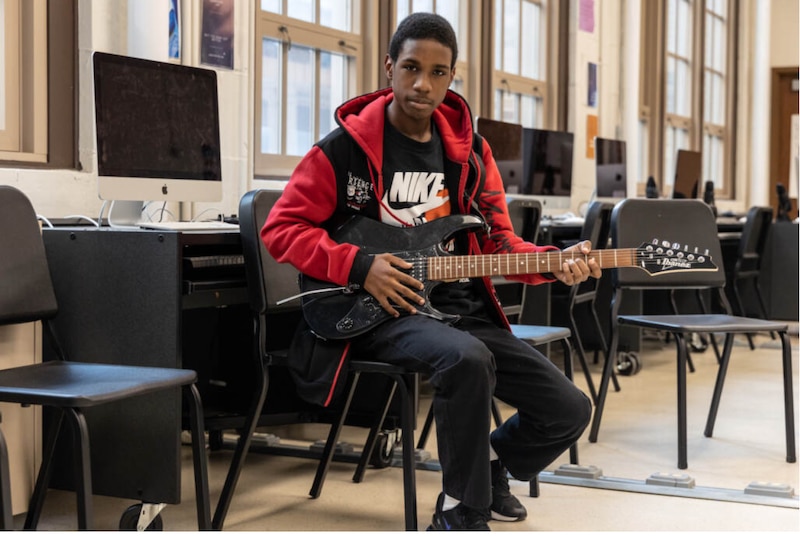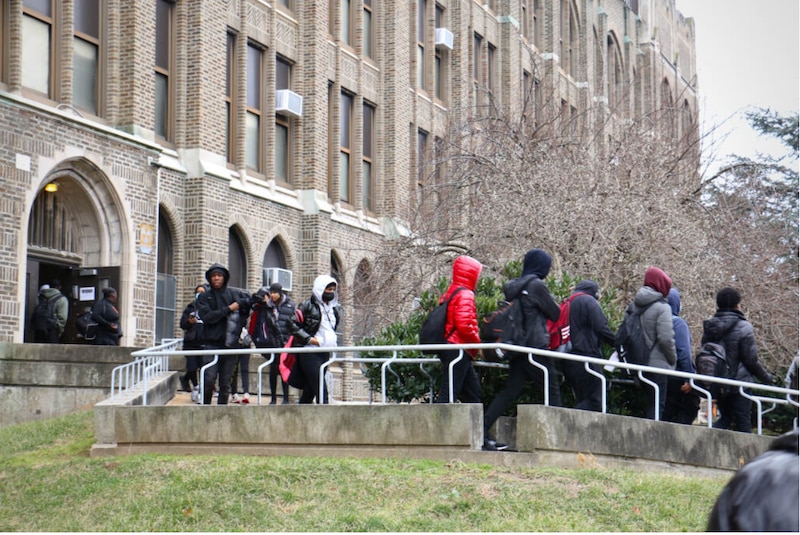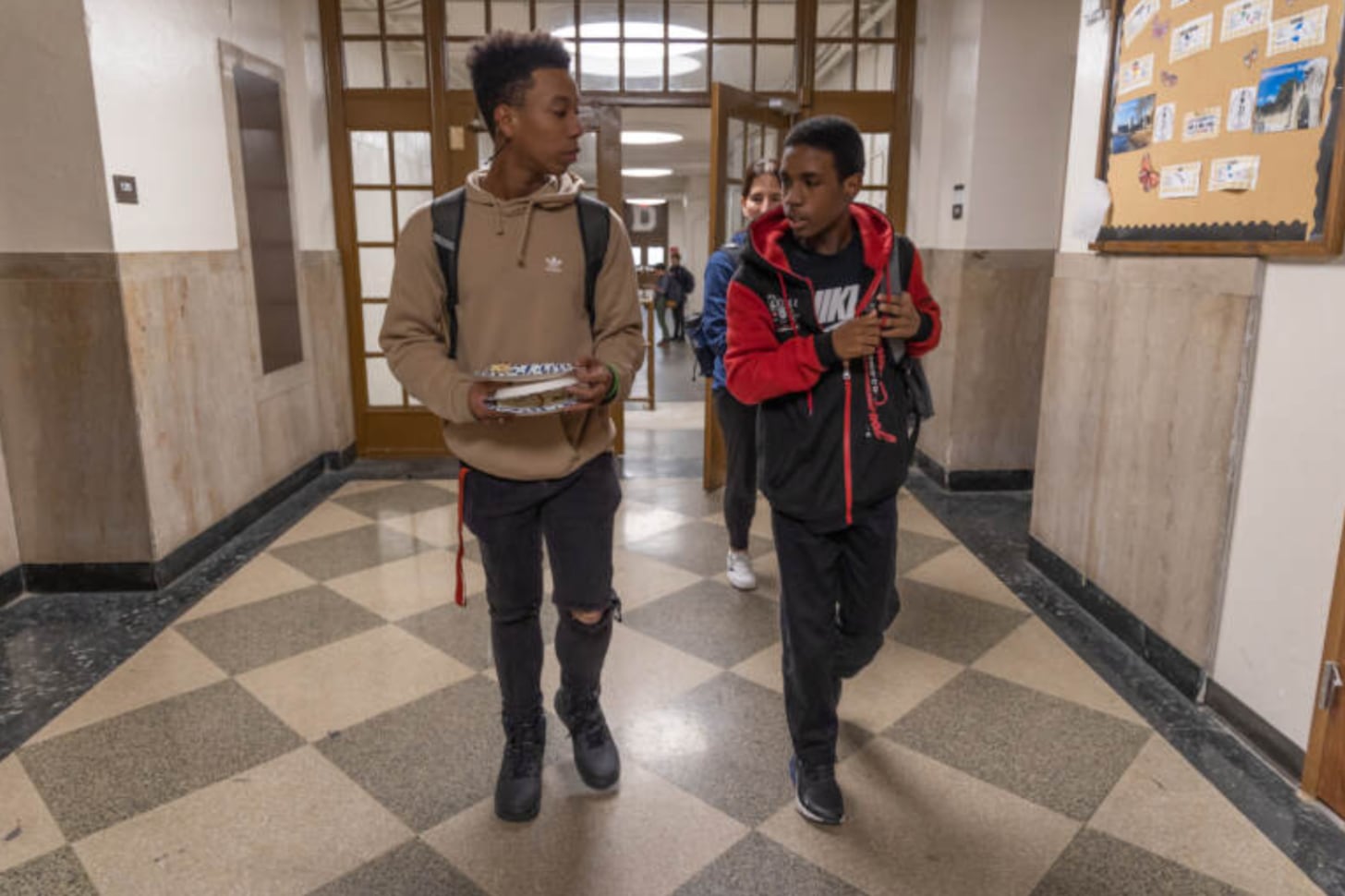Gun violence in Philadelphia takes a toll on students and their ability to learn and succeed. WHYY News’ education, gun violence, and health reporters look at the intersection of schools and violence in their new six-part series, “Safe Place.”
Synceir Thorton wears a red and black sweatshirt that’s too big for his small frame. The 16-year-old keeps the hood up, brown eyes peering out from underneath the fabric.
“I usually stay cautious nearly 24/7. I don’t really feel safe anywhere,” he said. “People come to school having a bad day and they want to hurt someone. I don’t want to be that someone.”
Like all students at Dobbins Technical High School in North Philadelphia, Thornton’s day starts with a walk through a metal detector. Fights are common outside of the school, so he stays inside for as long as he can.
“I’m in a club nearly every day or I’m just really strictly on my way home by bus and train,” he said.
Dozens of students walked out of Dobbins in December to protest what they describe as unsafe conditions: senseless acts of violence from students and a lack of teachers and security guards.
Thornton said he intentionally stays out of the loop on conflicts between students because they too often lead to gun violence outside school.
“It’s better if I don’t find out.”
More than 60% of young Philadelphians worry about their friends or family becoming victims of shootings, according to a survey conducted by local teens.
Educators say they have no choice but to respond to Philly’s ongoing gun violence crisis.
“We can’t solve the problem because our core business is teaching and learning, but we can be a partner in solving the problem,” said School District of Philadelphia Superintendent Tony Watlington in an interview.
Gun violence, like poverty, is another challenge predominantly large urban school districts have to deal with. If students aren’t safe, how can they be expected to learn? And when students are injured or killed by gunfire, the trauma ripples across classrooms and instills a fear in young people that they could be next.
Against the backdrop of Philly’s gun violence epidemic, school district officials, teachers, coaches, and principals are making changes — in and outside of classrooms — they hope will better protect children from threats both within schools and in surrounding neighborhoods.
More Philly shootings involve kids

Philadelphia had more shootings involving children last year than New York, a city with more than five times as many people.
Fewer than 100 shooting victims were under the age of 18 in 2017, compared to 217 in 2022, according to city data.
One possible explanation is the age of the shooters themselves. The number of young people arrested in shootings more than quadrupled during the same time period, from 21 to 117, according to data from the Philadelphia Police Department.
Julio Nuñez, the assistant principal at Gloria Casarez Elementary in Kensington, said schools bear some responsibility since they have the opportunity to help students stay on the right path.
“To think or assume that kids want to [become shooters] when they’re five years old is just naive,” he said.
Instead, he believes the more negative experiences a student has at school, the more likely they are to think the classroom isn’t a place for them. That underscores the importance of making sure schools are inclusive, well-resourced spaces where students can have positive experiences, Nuñez said.
Officials argue that people who drop out of high school are more likely to be involved in gun violence, putting pressure on schools to take a closer look at the experiences students are having in the classroom.
The district’s on-time graduation rate is roughly 70%, and the dropout rate for the 2020-21 school year was 14%, a district spokesperson said.
Watlington requested that the school board receive monthly attendance and dropout reports as part of his response to gun violence, an initiative that kicked off in December. Once the district has a better sense of which students have dropped out or are at risk, it can do more to ensure they remain engaged, he said.
“When young people … think they have a future ahead of them, I think they make good choices and less bad choices,” Watlington said.
Pride, bullying, and social media can lead to fights
The COVID-19 pandemic put unprecedented stress on families, including an increase in domestic violence, according to the American Journal of Emergency Medicine.
Dr. Caroline Watts, a psychologist at the University of Pennsylvania, said kids who are facing challenges at home are more likely to struggle at school and fight with other students. Cutting these students off from their support systems during the pandemic only made the situation worse, she said.
Poverty is also a factor, said Malik Smith, who works at the nonprofit Institute for the Development of African American Youth and helps monitor school campuses through the district’s new Safe Path program.
Smith said students feel insecure when they come to school hungry or without clean clothes.
“If they have any aggression in them, it’s going to come out when they feel embarrassed and humiliated like that,” he said.
Taahzje Ellis, a 17-year-old Dobbins student, said some students would rather skip lunch than get their meals from the cafeteria due to fear of judgment from other students.
“It’s embarrassing if you get the free lunch,” he said, adding that some students post photos of people eating the free food on social media. “It’s a whole Instagram page.”
Taahzje said most of the conflicts between students that he knows about started online.
“Then they get to school and they fight,” he said. “It’s just people fight over anything nowadays … You fight the wrong person and now they want to kill you because they lost or just because they fought.”
He said some teens don’t understand the potential consequences of their actions.
“If you’re killing someone, you’re taking their life away, something that you can never give back to someone,” he said. “I think people just need to understand that, because a lot of people are just wrapped up in a kind of fantasy that this is the ideal life.”
More violence near Philly schools

While shootings on district property are uncommon, recent violence near school buildings has shaken Philadelphia residents.
In September, 14-year-old Nicolas Elizalde was killed and four other students were injured following a scrimmage near Roxborough High School, after multiple gunmen ambushed members of the school’s football team.
And the day before Thanksgiving, four Overbrook High School students were injured in a drive-by shooting outside a beauty salon a block away from the school.
Another Overbrook student was shot on his way to school in late January. That’s despite the fact that Overbrook has a designated safety zone around it. These areas are determined by the Philadelphia Police Department to be at high risk for crime and have additional officer presence during dismissal.
Watlington, who took over the school district from William Hite in June, said that along with academics, his top priority is the safety and well-being of students and staff.
Watlington took eight “action steps” during his first 100 days, including hiring Edwin Santana, a community and political organizer and former teacher, to serve as a community liaison with a focus on gun violence.
While district officials have expressed a willingness to respond to the impact of community gun violence on students, they face several obstacles.
The district, like many in Pennsylvania, is understaffed. That means fewer teachers to supervise students and provide them with the experiences, like electives and after-school activities, many see as a solution to student disengagement.
Another challenge is funding. Pennsylvania contributes a smaller share of funding to public education than most other states, leaving districts to rely more heavily on local property taxes.
That’s a problem in Philadelphia, the poorest large city in the country. Historically, the city’s schools have been underfunded due to systemic issues like residential segregation, district boundaries, and white flight to the suburbs.
Even though residents are relatively highly taxed, because overall wealth in the city is low, officials say there’s a gap between the revenue they can raise and the money they need. The district has many students who require special education services, or other supports that make education costs more expensive.
Additionally, the School District of Philadelphia is not a taxing authority and cannot raise tax revenue on its own, unlike other districts in the commonwealth.
Watlington said there are things the district would like to do to help students deal with gun violence — like hire more counselors — but financially, it can’t afford to.
Roxborough shooting shatters sense of after-school safety
The shooting outside Roxborough High School destroyed the idea that after-school activities, like sports, are guaranteed safe spaces.
“What happened at Roxborough should never have happened,” said Jimmy Lynch, the district’s executive director of athletics. “I think it’s important for us as a society, as a school district, to not normalize that.”
The district’s athletics team has increased its level of communication with police since the shooting, Lynch said, and now shares its master schedule with the department so they can assign officers to cover events, including scrimmages, as necessary.
In a written statement, district officials said they have “significantly increased the safety officers covering after school sporting events” since the shooting.
“What’s the alternative?” Lynch said. “That we’re not going to have sports? That’s a non-starter.”
Athletics have been shown to improve student attendance, behavior, and academics. Rather than scaling back, Lynch said he remains focussed on expanding programs so more students can participate and benefit.
After the shooting, Pennsylvania’s Department of Community Economic Development gave Roxborough $500,000 to increase its security, including new cameras and updated door locks.
The Pennsylvania Department of Education awarded Overbrook the same amount of money in December to improve “safety and communications technology,” according to a press release.
The district recently received a $1 million grant from the U.S. Department of Justice for a violence reduction program at another school, John Bartram High School in Southwest Philadelphia. Christopher Braxton, a 17-year-old student, was shot and killed in January of 2022 shortly after he left the school.
In June, the city of Philadelphia said it would spend $1.8 million to install new security cameras near the 19 district schools most impacted by gun violence, including Bartram and Roxborough.
Philadelphia public schools have some cameras, but they’re outdated and don’t provide real-time information. The money is supposed to pay for 100 state-of-the-art security cameras spread amongst the schools.
Mayor Jim Kenney and City Council members also promised an additional $1 million in the city’s operating budget to hire analysts to review real-time footage.
The city completed school site surveys in November, but hasn’t purchased the cameras yet, according to a spokesperson from the Managing Director’s Office. The spokesperson also said Philadelphia is experiencing supply chain issues that have made the technology harder to acquire.
The district’s new plan
In December, the School District of Philadelphia announced its new plan to address gun violence in the form of an op-ed from Watlington.
The op-ed followed a column from The Philadelphia Inquirer’s editorial board that described “violence and disruption” as the norm at many schools and called on the district to take action.
Watlington’s plan includes five points:
Expanding the district’s Safe Path program, which pays adults to monitor dismissal, mediate conflicts, and ensure students get home safely. The program, which launched at six sites at the beginning of the academic year, will be expanded to 12 more schools over the next two years. The district will invest $250,000 on top of its roughly $500,000 initial investment.
Watlington said the district hasn’t evaluated the impact of its program so far, but that data from a similar program in Chicago, which served as the district’s model, has been encouraging.
One study found a double-digit drop in violent crime on streets where monitors were present even after they had gone home for the day.
But implementing Safe Path in Philadelphia hasn’t been easy. The district’s chief safety officer Kevin Bethel said at December’s school board meeting that recruiting enough adults to staff the program has been challenging.
And the program itself isn’t a cure-all. Roxborough is one of the eight schools where Safe Path is already in place. At the time of the deadly September 2022 shooting, monitors had already gone home for the day.
Increasing safety zones around school communities by hiring police officers. The district will hire Philadelphia Police Department officers to “address safety issues outside of the school building that warrant an increased police presence,” using a $600,000 grant.
When asked why the district needs to hire city police officers itself, rather than just coordinate with the department, Watlington framed the decision as necessary given the recent level of violence.
“I think these extreme and unacceptable incidents that we are experiencing require us to do something better and different and we need more police officers,” he said. “We’re gonna bite the bullet and pay for them.”
Philadelphia police officers are already present during school dismissal in 27 safety zones that cover 40 district and charter schools through a joint district and PPD program known as Safe Zones.
Watlington said officers were able to respond “more quickly” to the drive-by shooting near Overbrook High School last month because they were in the area as part of the program.
New online mental health services will be available for teachers and students in grades 6-12. Students will have access to licensed counselors, peer support, and “therapeutic” activities through a one-year pilot program paid for by the state. Kooth, a digital mental health platform that’s popular in the United Kingdom, will provide the services.
Watlington said he’s heard from many students that the ratio of counselors to students, which is 269-to-1, is insufficient. The American School Counselor Association’s recommended ratio is 250-to-1.
“The ratio is just too high for them to be able to talk with their counselors. Some of them don’t get a chance to see their counselor at all,” he said.
The district has a contract with Lyra Health to provide mental health benefits to employees, including therapy and coaching.
Evaluating attendance and dropout data to make sure students are going to school and not getting involved in gun violence. Watlington said once he knows which schools and learning zones are struggling the most, he can figure out what to do next. He’s promised to share this data publicly during monthly board of education meetings.
Attendance rates plummeted during the height of the pandemic and have been slow to rebound in school districts across the country. Enrollment is also down, leaving districts to wonder whether students have enrolled elsewhere or disappeared.
“We need to redouble our efforts to try and account for each and every student,” Watlington said.
Addressing specific school needs, including at Dobbins, where The Philadelphia Inquirer first reported on safety concerns.
Watlington said the district hired a retired administrator to address safety and culture concerns at Dobbins. The school has since stationed staff throughout the building to make sure all areas of the building are monitored during arrival and dismissal, and when students are changing classes, a spokesperson said.
Dobbins student Taahzje said while he feels safe inside his school, fights happen frequently on the sidewalks right in front of or across from the building.
“If I was an adult, I would not drive through Dobbins after school because there’s a high chance there’s a fight or something and now you’re stuck in traffic,” he said. “You never know what’s going to be happening at the school.”
Dobbins is set to receive after-school monitors as part of the district’s expanded Safe Path program, but with hiring challenges in play, it’s unclear when more support will come.
Thornton said he’s tired of all of the fighting. “I don’t understand how actual fighters that fight in a ring can get along better than we can,” he said.






